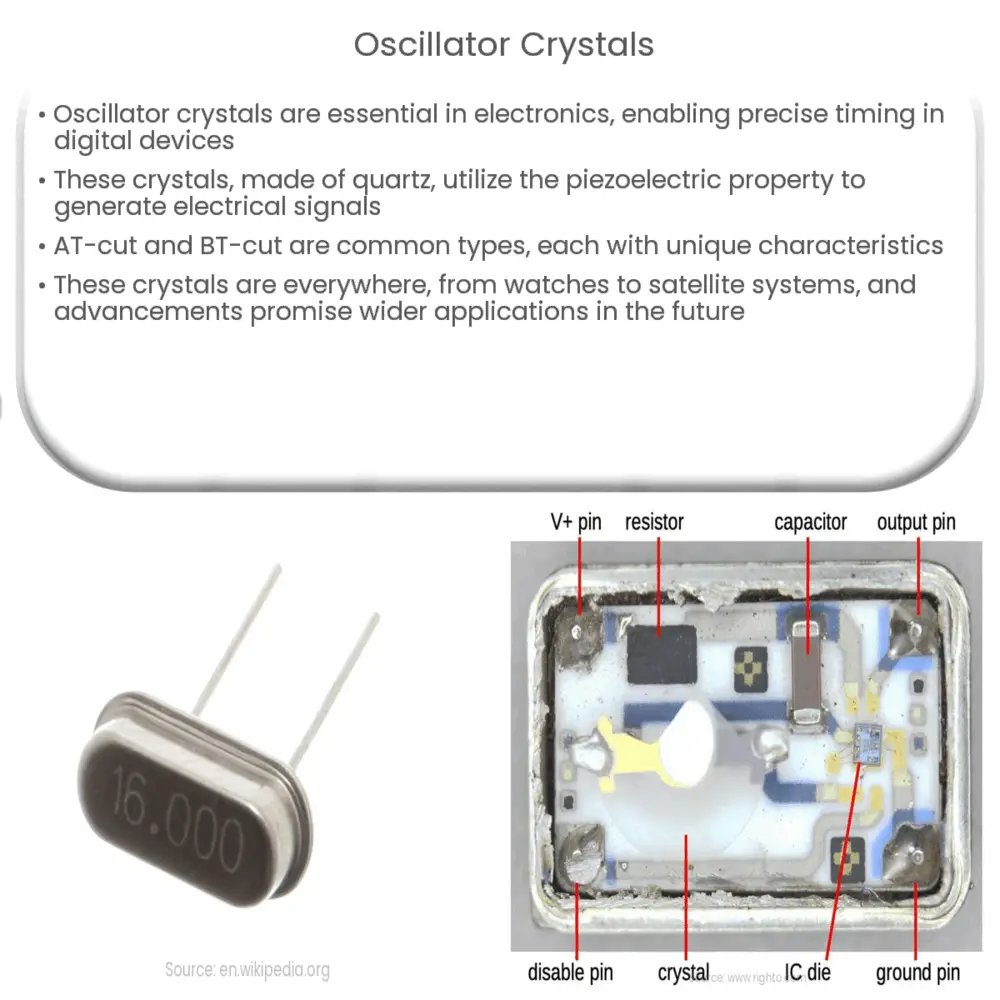Explore the world of oscillator crystals: their workings, applications, limitations, and future prospects in modern digital technology.

Oscillator Crystals: The Heartbeat of Modern Technology
Oscillator crystals are vital components in the field of electronics, finding wide-ranging applications from wristwatches to global positioning systems. Often referred to as “quartz crystal oscillators,” these devices provide a stable time base for electronic circuits, enabling precise timing and synchronization in numerous digital devices.
Understanding Oscillator Crystals
At its core, an oscillator crystal is a tiny slice of quartz, a mineral composed of silicon and oxygen. Quartz possesses a special property called piezoelectricity, which means it can convert mechanical pressure into electrical energy, and vice versa. This property is exploited in oscillator crystals to generate a steady stream of electrical signals or pulses.
Functioning of Oscillator Crystals
The working of oscillator crystals revolves around the piezoelectric property. When a voltage is applied to a quartz crystal, it vibrates at a specific frequency, determined by its physical dimensions and the angle at which it was cut from the original crystal. These vibrations generate an electrical signal that can be harnessed to drive a circuit.
Types of Oscillator Crystals
- AT-Cut Crystals: These are the most commonly used oscillator crystals today. AT-cut crystals are cut at an angle of 35°15′ to the optical axis of the quartz. They offer a good balance between temperature stability and frequency.
- BT-Cut Crystals: BT-cut crystals are cut at a larger angle of 49° from the optical axis. They are less temperature stable but offer higher frequency stability.
While AT-cut and BT-cut are two main types, other cuts such as SC-cut, IT-cut and CT-cut also exist, each with its unique performance characteristics.
Applications of Oscillator Crystals
Thanks to their ability to provide stable and reliable timing signals, oscillator crystals find ubiquitous use in digital devices. They are integral components in a vast array of technology we rely on daily, from mobile phones and computers to automobiles and satellite navigation systems.
Limitations of Oscillator Crystals
Despite their widespread use and inherent benefits, oscillator crystals are not without their drawbacks. They are susceptible to temperature changes, mechanical stress, and aging, all of which can influence the frequency of oscillation and, thus, the performance of the electronic device they are part of.
In the following sections, we will delve deeper into the working principles, applications, and the future of oscillator crystals.
Working Principle of Oscillator Crystals
At the heart of an oscillator crystal’s operation is the piezoelectric effect. When a voltage is applied across a piece of quartz, it oscillates at a natural frequency. This oscillation is stable and precise, creating a ‘ticking’ signal that can be used by electronic devices to keep accurate time. The frequency of oscillation depends on the size, shape, and the cut of the quartz crystal. By altering these factors, manufacturers can create crystals that oscillate at virtually any desired frequency within a certain range.
Advanced Applications
Oscillator crystals are not just confined to mundane applications like timekeeping in watches or providing clock signals in computers. These crystals are also extensively used in scientific and industrial applications. For instance, in telecommunication systems, they are employed to stabilize frequencies of radio transmitters and receivers. In scientific research, quartz crystal microbalances are used to measure tiny masses in the nanogram range.
The Future of Oscillator Crystals
With the advent of MEMS (Micro-Electro-Mechanical Systems) technology, the future of oscillator crystals looks promising. MEMS oscillators, which are even smaller and more power-efficient than quartz, are increasingly being used in IoT (Internet of Things) devices and wearable technology. However, quartz still remains the go-to material for oscillator crystals due to its excellent stability and reliability.
Overcoming Limitations
While oscillator crystals have limitations like temperature sensitivity and aging effects, these can be mitigated. Oven-Controlled Crystal Oscillators (OCXOs) are used in applications where high stability is necessary. Here, the crystal is maintained at a constant temperature to prevent frequency drift. In addition, advances in technology and materials science are consistently pushing the boundaries of what’s possible with oscillator crystals.
Conclusion
In conclusion, oscillator crystals play a pivotal role in our digital world. From keeping time in wristwatches to ensuring the accurate functioning of complex electronic systems, these tiny components are truly the unsung heroes of modern technology. Although they have certain limitations, ongoing advances in technology are overcoming these, promising even wider applications in the future. As we continue to push the limits of miniaturization and power efficiency, oscillator crystals will undoubtedly remain at the forefront, serving as the heartbeat of our increasingly digital world.

